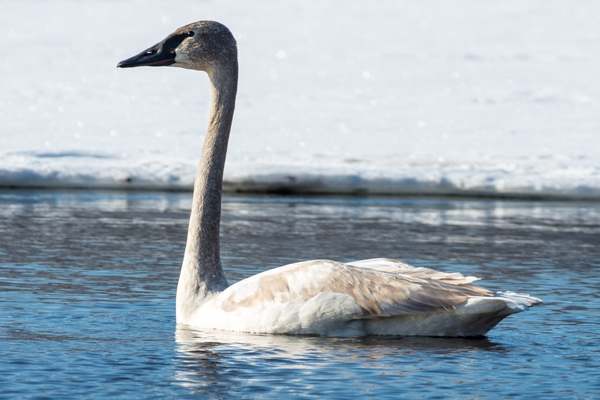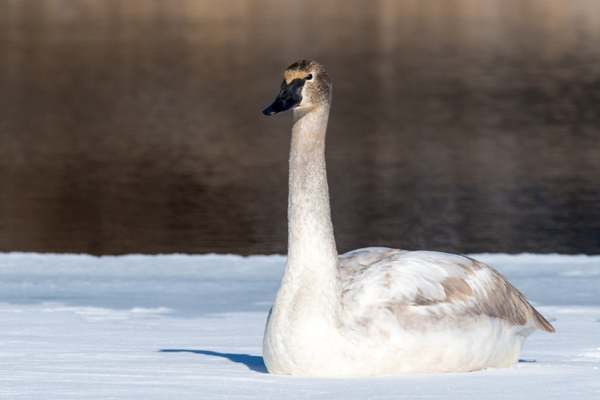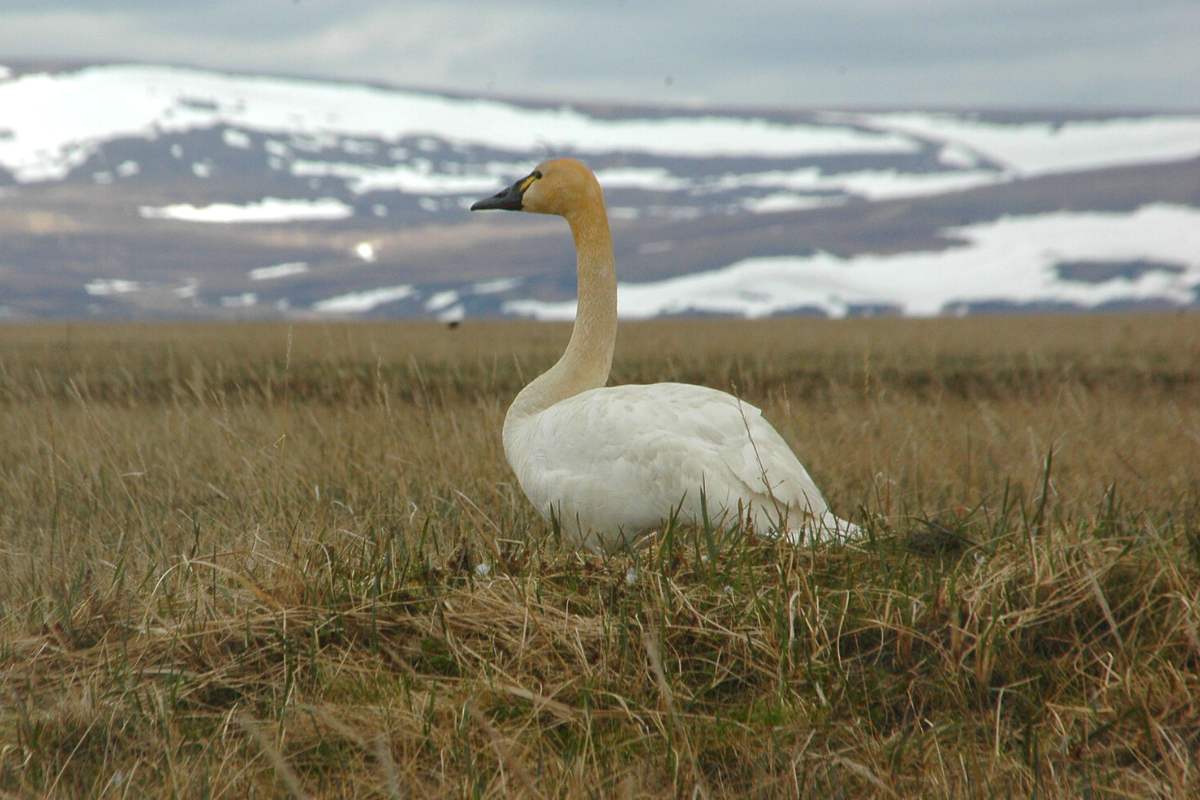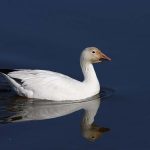Common Name: Tundra Swan
Scientific Name: Cygnus columbianus| Size | Diet | Range in Hawaii | Status in Hawaii |
|---|---|---|---|
| 36 in. - 60 in. | seeds, roots, aquatic plants and invertebrates | Maui and Kauai | Least Concern |
The tundra swan (Cygnus columbianus) is a large, majestic waterbird that is native to the Arctic tundra. Although they are typically found in northern regions of North America and Eurasia, tundra swans have been known to migrate to other areas, including the Hawaiian Islands. With their striking appearance and distinctive calls, tundra swans are a captivating sight to behold.
Tundra swan
Appearance

In general, tundra swans are large birds, with a wingspan of up to 7 feet and a body length of up to 4 feet. They are typically between 36 and 60 inches long, with males being slightly larger than females. It has a white body and black legs and feet. The bill is black with a yellow spot at the base, and the eyes are dark.
Male and female tundra swans are similar in appearance, but males are slightly larger. Juvenile tundra swans are similar to adults, but they have a gray bill and may have a few gray feathers mixed in with their white plumage.
Diet
They are omnivorous, which means they eat a wide variety of plant and animal matter. In the wild, they feed on seeds, roots, and aquatic plants, as well as small invertebrates such as insects, snails, and worms.
During the breeding season, tundra swans feed primarily on plant matter, including the leaves, stems, and seeds of grasses and other aquatic plants. They also feed on the roots, tubers, and leaves of aquatic and marsh plants. In some cases, they have been known to feed on agricultural crops, such as corn and wheat.
In the winter, tundra swans rely more on animal matter, such as insects, snails, and worms, which are more readily available in the colder months. They may also feed on the remains of fish and other aquatic animals that have died.
Behavior
Tundra swans are social birds and are often found in small flocks. They are most active during the day and spend their time foraging for food, preening their feathers, and resting. They are also strong swimmers and divers and can be seen swimming and diving underwater in search of food.
These birds are territorial during the breeding season and will defend their territory against intruders. They are known to be vocal birds and make a variety of calls, including honks, whistles, and trills. Their calls can be heard from a distance and are often used to communicate with other members of the flock.
Tundra swans are migratory birds and are known for their long, annual migrations. They typically travel in large flocks, and their migration patterns are thought to be influenced by factors such as food availability and weather conditions.
Nesting
During the breeding season, tundra swans build nests on the ground, often near water, and line the nest with feathers and other soft materials. The female tundra swan typically lays a clutch of 4-7 eggs, and she alone incubates the eggs for an average of 30-35 days.
The male usually remains nearby to defend the nest and the female while she is incubating the eggs. Once the eggs hatch, the female leads the cygnets (baby swans) to water and helps them learn to swim and forage for food. The cygnets are able to fly at about 8-10 weeks of age.
Habitat

Tundra swans are typically found in wetlands, such as marshes, lakes, and rivers. They are also known to use agricultural fields, particularly during the winter months when natural food sources are scarce. In some cases, tundra swans have been known to nest in more urban areas, such as parks and golf courses.
Range
According to ebird.org, tundra swans have been occasionally observed in the Hawaiian Islands, specifically on the islands of Maui and Kauai. Tundra swans are migratory birds that breed in the Arctic tundra during the summer months and migrate to more temperate areas, including parts of the United States and Canada, during the winter.
It is likely that the tundra swans observed in Hawaii are non-breeding birds that have migrated to the islands from their breeding grounds in the Arctic. While tundra swans are not native to Hawaii and do not breed in the islands, they may occasionally be seen passing through during their migration.
Conservation Status
Tundra swan is listed as a species of “Least Concern” by the International Union for Conservation of Nature (IUCN) globally, which means that it is not considered to be at risk of extinction.
Interesting Facts
1. They are vocal birds
They make a variety of calls, including honks, quacks, and whistles. The calls of tundra swans are usually higher-pitched and more musical than the calls of other swan species. The calls of male tundra swans are generally louder and more powerful than those of females.
2. They are strong fliers
Tundra swans have powerful flight muscles that allow them to flap their wings rapidly and generate a lot of thrust. These muscles, which make up about 25% of the swan’s body weight, are among the strongest of any bird. They allow tundra swans to fly at speeds of up to 55 mph, which is faster than most other waterfowl.
3. Slow-flapping flight style
They are known for their graceful, slow-flapping flight style, which is characterized by a series of slow wingbeats followed by a gliding descent.
4. They are strong swimmers and divers
Tundra swans are adapted for swimming and diving, with a streamlined body shape and long, flexible neck that allows them to move easily through the water. They also have waterproof feathers that help keep them dry and warm while they are in the water.
Frequently Asked Questions:
How common are tundra swans in Hawaii?
Tundra swans are not regularly found in Hawaii and are considered to be rare visitors to the state. This means that they are not present in large numbers and are not regularly observed in the state. Tundra swans have been observed on the islands of Maui and Kauai, but they are not commonly found on other islands in the state.
How do tundra swans migrate?
Tundra swans are migratory birds that fly long distances between their breeding and wintering grounds. They migrate in large flocks and are known for their graceful, slow-flapping flight style.
During migration, tundra swans follow traditional flyways, or routes, that lead them to their breeding and wintering grounds. These flyways are determined by a variety of factors, including the availability of food, suitable habitat, and the presence of other tundra swans.
What habitat do tundra swans prefer in Hawaii?
Tundra swans prefer habitats that provide access to food, water, and suitable nesting sites, and they are often found in areas with a mix of wetland and upland habitats. In Hawaii, tundra swans have been observed foraging in wetland habitats, where they feed on a variety of plant and animal matter, including seeds, roots, tubers, invertebrates, and small fish.
They are also known to feed on agricultural crops, such as rice and sugarcane, and they may be attracted to these areas because of the availability of food.




